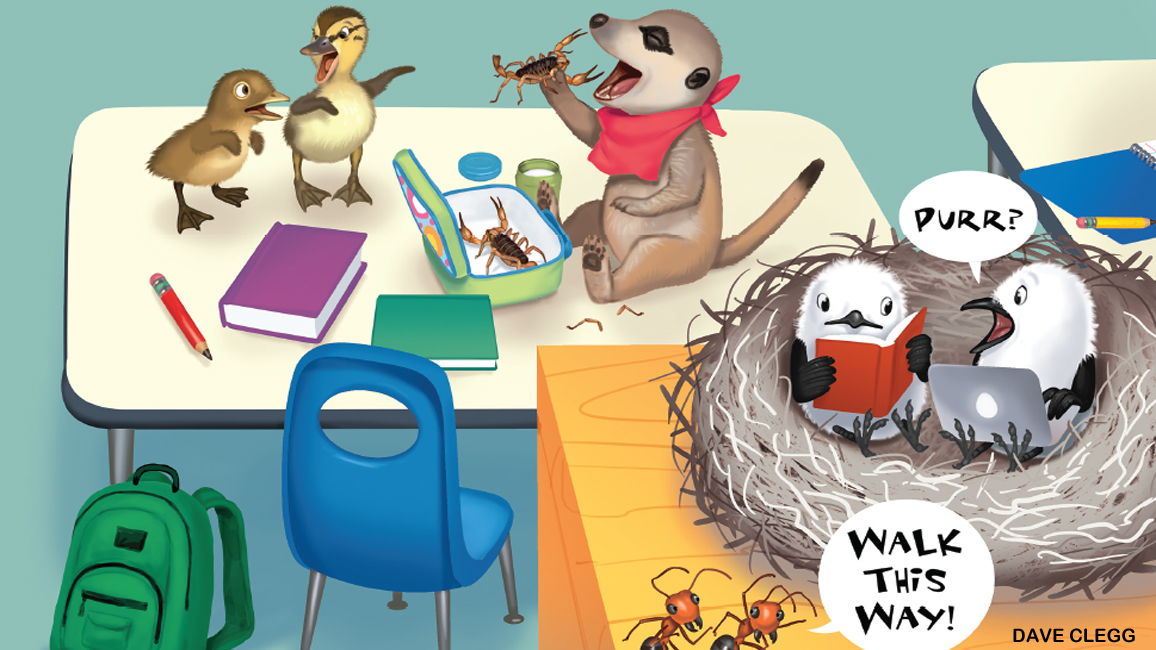
Welcome to Animal School
By Anne Cissel; Art by Dave CleggNo—animals don’t sit in a classroom like this. But ants, chimps, and lots of other creatures are excellent students!

Have you learned your times tables yet? If so, you know it takes lots of practice. Wild animals may not need to know 2 X 3 = 6. But they DO need to learn other skills in order to survive.
Animals are born knowing some things already. We call those instincts. A tiger cub, for example, knows right away how to nurse and make “I’m hungry” cries. But later, that cub will need to learn the best way to hunt. Instincts will help a little, but the cub will learn a lot from watching adult tigers and by practicing. Let’s take a look at the amazing ways other creatures get smarter!
SECRET CODE
An Australian bird has figured out a way of teaching its chicks—even before they have hatched! Superb fairywren mothers use a special, one-of-a-kind call near their eggs. When their chicks hatch, they already know how to use that call to ask for food. The call is different for every fairywren family, kind of like a last name.
Why teach a call so early? A kind of cuckoo often lays its eggs in fairywren nests. There’s a chance that the fairywren parents won’t notice and will feed the stowaway chick as one of their own. But since the imposter chick won’t know the “secret password,” the fairywren Mom or Dad most likely won’t be fooled!

FOLLOW THE LEADER
School is in session . . . for rock ants! These tiny insects teach each other how to find food. Here’s how it works: When one ant finds a snack, it returns to its nest and releases a special scent called a pheromone (FAIR-uh-mohn). This gets another ant to follow it. The first ant moves forward a little bit, then waits for its student to memorize the landmarks along the way.
When the student is ready to move on, it touches its antennae (an-TEH-nee) to its teacher’s back. It’s saying, “I get it. Let’s move on!” Then they repeat the same thing for the next section of the journey. It’s sort of like an experienced guide leading hikers along a hard-to-follow trail. The cool thing about this “ant school” is that the student can become another teacher and lead more ants to the food.
SCORPION SCHOOL
Imagine you are teaching a toddler how to solve jigsaw puzzles. Probably, you’d start with a puzzle with big, chunky pieces that easily fit together. As the child grows, you’d offer more and more difficult puzzles. After lots of practice, the child might be able to put together a 1,000-piece puzzle!
Meerkats do something like that with their babies, or pups, when teaching them to hunt. Grown-up meerkats take turns bringing food to the pups. At first, they bring already-dead insects and other creatures. But as the pups grow, the adults often deliver animals that aren’t quite dead yet, so the pups can practice hunting with wounded prey. They even give the pups still-alive scorpions, removing their stingers first. As the pups become better hunters, the adults will bring livelier and livelier creatures. Eventually, the pups will be able to handle all of their creepy-crawly meals on their own!
BIRD “WORDS”
Do your parents use a certain phrase that tells you they are serious? Maybe they say, “Come here this instant!” Whatever the words, when you hear them, you know Mom or Dad means business.
In the Kalahari Desert in southern Africa, southern piedbabblers use a purr-like call to tell their chicks that food is on the way. When the baby birds get bigger, the adults use the same call to move the youngsters away from predators or toward good food. So, the young birds have learned that “purr” means, “Head to Mom and Dad RIGHT NOW!”

PLAYING TO LEARN
Did you know that when you play you are doing more than just having fun? Playing is also a form of learning. You are figuring out how the world works and practicing important skills. Scientists think that some animals play for the same reasons.
Cheetah cubs, for example, often pounce on each other and wrestle. They may look fierce, but they aren’t trying to hurt each other. Most likely, these tussles help them learn how to fight and hunt—skills they will need later in life. But it is probably a lot of fun, too!
CHIMP HOMESCHOOL
A young chimpanzee spends a lot of its time on its mother’s back, watching what is going on in its ape family. There is so much to see! The chimp baby watches its relatives making and using tools, picking the best foods to eat, and “talking” to each other with their voices and facial expressions.
Sometimes the skills chimps need are very hard to learn. Scientists say that’s when chimp moms do something that looks a lot like teaching. Moms make sticks into tools that they use to fish out termites from a mound. Termites are a favorite meal for chimps. If their children seem interested in the tool, then they hand it to them to try.
LOONY LEARNING
Sometimes animals can learn the wrong things. A few years ago, scientists discovered a pair of loons that had adopted a mallard duckling. This was unusual, because mallards and loons don’t get along very well in the wild. But the duckling began learning loon behaviors. It started eating fish, even though mallards usually prefer eating plants and insects. It also rode on its parents’ backs and dove to the bottom of the lake to find food—all things loons do, and mallards don’t!
















